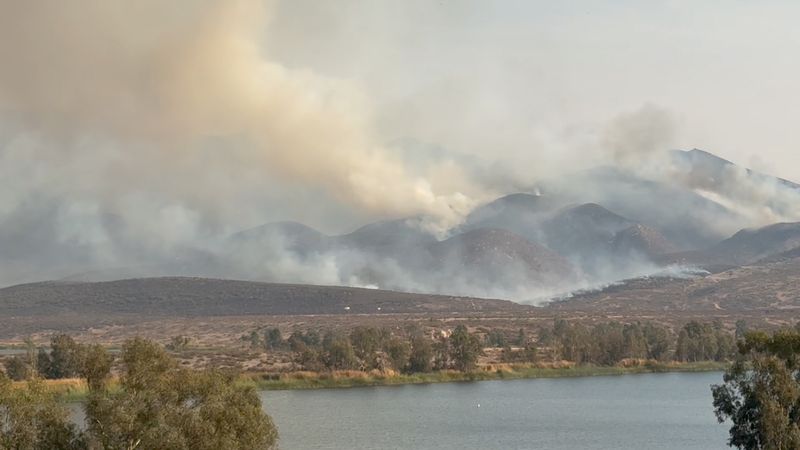By Ann Saphir
LOS ANGELES (Reuters) - Wearing a respirator, goggles, gloves and white protective booties, Shaun Kearney gazed at his house in Sunset Mesa, a coastal community next to Pacific Palisades. It survived the fires destroying Los Angeles, but the weekend forecast is for a different problem: rain.
Kearney needs to seal a hole in the roof to stop precipitation that he fears will be laced with toxins.
The hazardous chemicals belched from burning homes and cars are top of mind for Kearney as he thinks about recovery and rebuilding that he believes will take years.
Most of the neighboring homes were built before 1979, when asbestos was freely used in construction and those houses were reduced to ash.
"Even though our house is still standing, we obviously can't live here," said the fashion business executive, the CEO of Harry Styles' "Pleasing" brand. "It will be worse when they start removing the debris -- that's my biggest concern."
The fires, which began on Jan. 7 and are still not fully contained, have killed 28 people and damaged or destroyed nearly 16,000 structures. The rain will bring cleaner air and improve fire-fighting conditions, but some authorities have expressed concern that overall rain will make things worse.
Fire "ripped through homes, vehicles, electronics, plastics, chemicals, furniture, and countless everyday materials, creating a dangerous mix of toxins," LA Councilmember Traci Parks warned residents this week as she announced efforts to contain the runoff. "When it rains, they flow into our gutters, storm drains … eventually our beaches."
On Friday, workers placed concrete barriers used to control highway traffic along the Pacific Coast Highway and in Palisades neighborhoods above the coastline to prevent landslides, like those that killed 21 and caused hundreds of millions of dollars of damage after a fire seven years ago in Santa Barbara County.
Other workers put cloth covers and straw barriers around storm drains to filter out pollutants and slow water flow.
Trucks hauled away burned-out cars, many of which are toxic messes. The work is far from done: hulls of incinerated cars line roadsides and fill driveways, and many drains appeared unprotected.
Much of the work observable in the Palisades focused on capping broken gas and water pipes, repairing power lines and patching roads. President Donald Trump visited the area on Thursday.
The forecast for Saturday, Sunday and Monday is light rain. Still, the U.S. Geological Survey says that short, intense rain can trigger debris flows, with a map showing that much of the area of the Palisades and Eaton (NYSE:ETN) fires would have a high likelihood of hazard with a 15-minute burst of rain dropping between a quarter and half an inch (6-13 mm).
While toxins from burned houses are at least partially contained by their foundations, vehicles and mobile homes are typically parked on impermeable surfaces like asphalt, so when rainwater picks up metals from burned car batteries or tires, it can run straight into the storm sewers.
"There is nothing containing that ash," says Jackson Webster, professor of civil engineering at California State University Chico, who studied the effects of the 2018 Camp Fire in Northern California.
While the immediate danger to human health from dirty stormwater may be limited, he said, the impact on ecosystems including the ocean has not been well studied. Runoff could also sink into soil, contaminating gardens and once well-tended grounds.
SOME POSITIVES
In recent days police have escorted hundreds of residents like Kearney back into previously evacuated areas where, even blocks from the worst damage, there are still frequent whiffs of acrid ash. Rain will help, experts say.
"There is no downside, from the air perspective ... a light rain like this is a good thing," says UCLA Institute of the Environment and Sustainability Professor Suzanne Paulson, who studies air pollutants and says falling water captures airborne particles and deposits them in the soil where they cannot be breathed in.
But to many residents, the risks from toxins are incalculable.
"That is the reason we are not staying here. It is an unknown," said Jose Montelongo, 46, a general contractor whose rented home in the Pacific Palisades was not destroyed in the fire. They have a young son, he added. "It's not worth finding out."
Daniel and Miriam Dvorsky, with their son Jake, were sifting through the ruins of their burned-out home a few blocks from Kearney's home in Sunset Mesa on Friday, looking for heirlooms passed down from grandparents. There was little to salvage.
"We would like nothing more than to rebuild," said Daniel, who, along with his wife wore white coveralls and N95 masks provided by the Red Cross. He added, however, that he feels that political, economic and environmental constraints may make reconstruction difficult.

A couple of firefighters drove by in a truck. "Anything I can help you with," one asked.
Daniel, lounging on a blue lawn chair -- one of his only belongings that remained unscathed -- replied: "A Scotch, maybe."